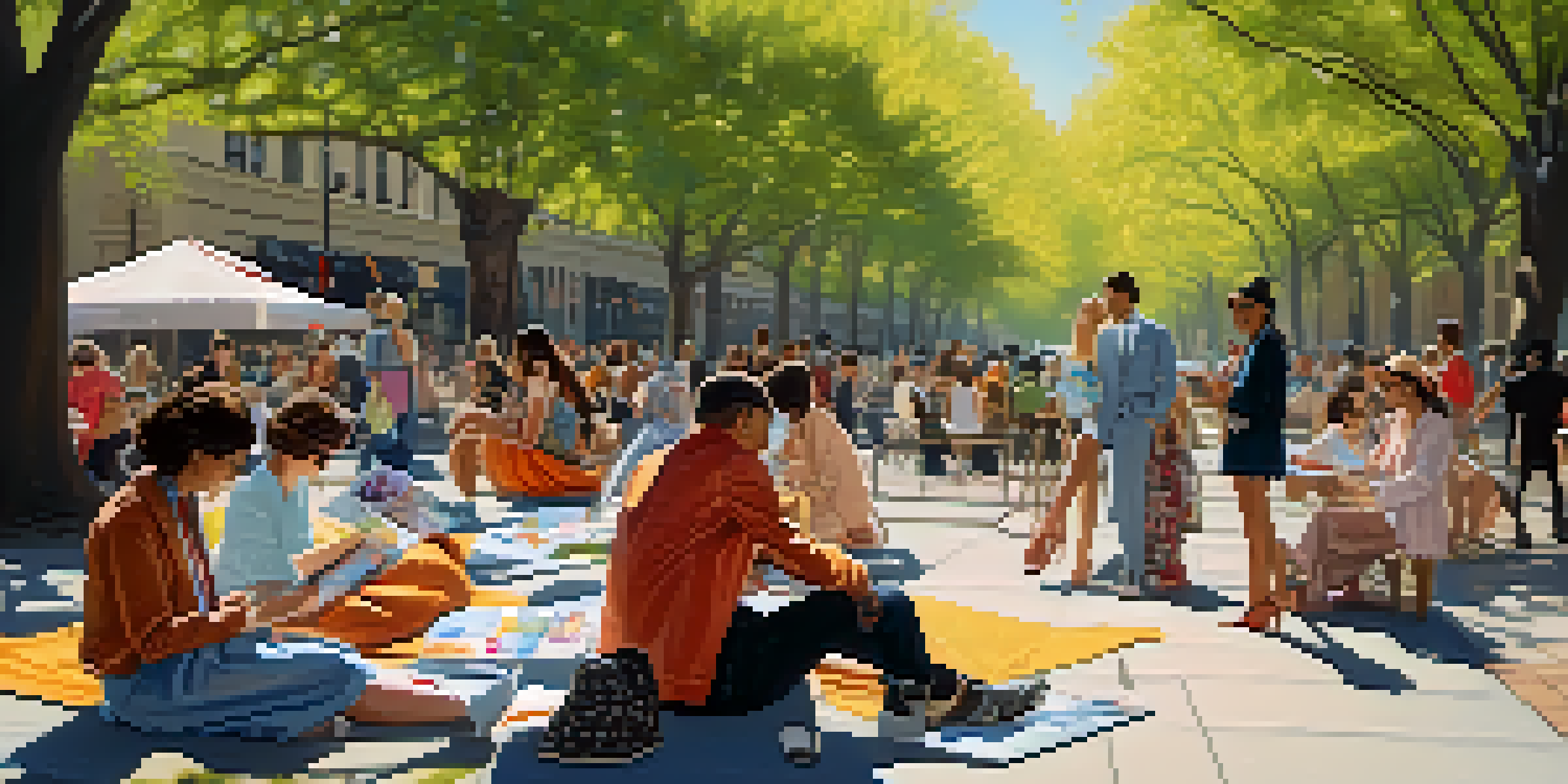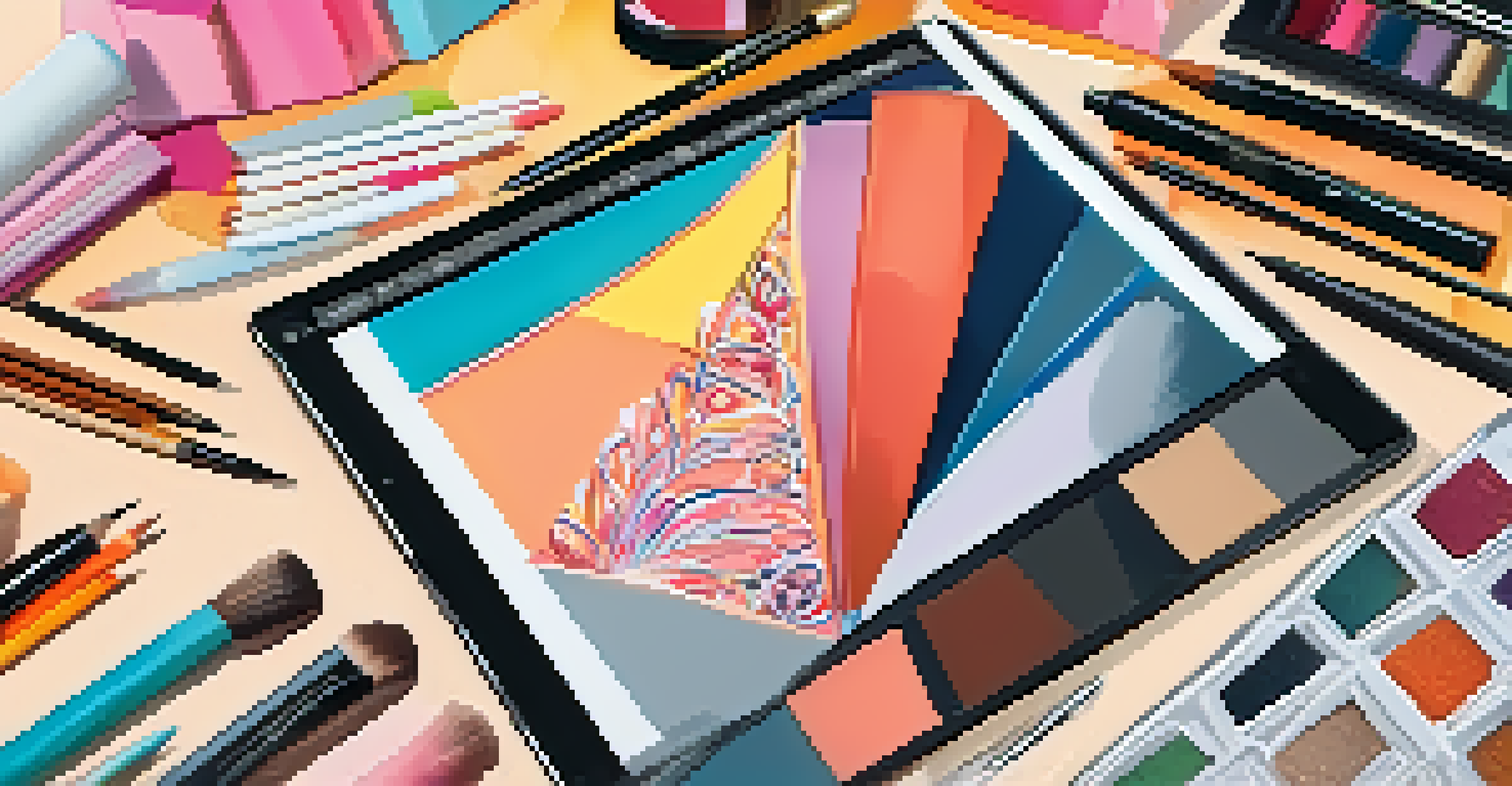The Influence of Social Media on Fashion Illustration Trends

The Rise of Digital Platforms in Fashion Illustration
In recent years, digital platforms like Instagram and Pinterest have transformed how fashion illustrations are shared and consumed. Artists can showcase their work to a global audience instantly, breaking geographical barriers that once limited exposure. This shift has not only democratized access to fashion art but has also encouraged a diverse range of styles and voices to emerge.
Fashion is about dreaming and making other people dream.
Moreover, the visual nature of these platforms allows for immediate feedback and engagement, fostering a vibrant community of artists and enthusiasts. Many illustrators find inspiration through likes, comments, and shares, which can influence their future creations. This interactive environment promotes a collaborative spirit, where artists often inspire one another.
As a result, we see a blending of traditional techniques with modern aesthetics, creating unique illustrations that reflect current trends. Such accessibility has invigorated fashion illustration, making it more relevant and dynamic in today's fast-paced digital world.
Influencers and Their Role in Shaping Trends
Fashion influencers have become key players in the world of fashion illustration, often dictating what styles and trends gain traction. Their ability to curate their image and share it with millions allows them to set standards for what is 'in' or 'out.' This influence often extends to the artists who illustrate these styles, as they adapt to showcase what is currently popular among influencers.

For example, an influencer's post featuring a unique outfit can inspire illustrators to create their interpretations, leading to a surge in similar styles being illustrated across various platforms. This creates a cycle where influencers and illustrators feed off each other's creativity, pushing the boundaries of fashion representation.
Digital Platforms Transform Fashion Art
Social media platforms have democratized fashion illustration, enabling artists to reach global audiences and foster diverse styles.
Furthermore, collaborations between fashion illustrators and influencers can amplify trends even more. When an artist creates exclusive illustrations for an influencer, it garners attention and can lead to viral content, further solidifying the illustrator's place in the fashion industry.
User-Generated Content and Its Impact
User-generated content (UGC) is a game-changer in the fashion illustration realm. As everyday users share their outfits and style choices, they inadvertently create a wealth of visual content that illustrators can draw inspiration from. This has shifted the focus from high-fashion only to include street style and personal aesthetics, making fashion illustration more relatable and diverse.
Art is the most beautiful of all lies.
Additionally, UGC allows illustrators to tap into trends that may not have been on their radar. By observing what real people are wearing and sharing, artists can adapt their work to reflect a broader spectrum of fashion. This leads to a richer and more inclusive representation of style.
Moreover, when illustrators showcase UGC in their portfolios, it resonates well with audiences who appreciate authenticity. This connection between artists and their audience fosters a sense of community, encouraging more people to engage with fashion illustration.
The Role of Hashtags in Discoverability
Hashtags play a crucial role in the discoverability of fashion illustrations on social media. By using relevant hashtags, artists can ensure their work reaches a wider audience interested in specific styles or trends. This strategic use of hashtags allows illustrators to connect with potential fans and clients who may not have found their work otherwise.
For instance, a simple hashtag like #FashionIllustration can expose an artist's work to thousands of users searching for that exact term. Furthermore, trending hashtags can create opportunities for illustrators to participate in popular discussions, thereby increasing their visibility.
Influencers Drive Fashion Trends
Fashion influencers play a crucial role in shaping trends, inspiring illustrators to adapt their work to reflect popular styles.
In essence, hashtags serve as a bridge between illustrators and audiences, enabling a more engaged and interactive experience. This has led to a flourishing ecosystem where both artists and followers can discover, share, and celebrate fashion illustration.
Emerging Technologies Influencing Illustration Styles
As technology continues to advance, so does the art of fashion illustration. Tools like augmented reality (AR) and virtual reality (VR) are beginning to play a role in how illustrations are created and experienced. This technological integration not only enhances the visual appeal but also offers new ways for audiences to interact with fashion art.
For example, AR filters on social media platforms allow users to 'try on' illustrated outfits, merging reality with art. This innovative approach opens up endless possibilities for illustrators to engage their audience in exciting ways, transforming static images into interactive experiences.
The adoption of these technologies means that illustrators must stay updated with the latest trends to remain relevant. As a result, we see a shift toward more dynamic and experimental styles, pushing the boundaries of traditional fashion illustration.
The Influence of Globalization on Styles
Globalization has significantly impacted fashion illustration trends, blending influences from various cultures and regions. Social media allows artists from different backgrounds to share their unique styles, leading to a rich tapestry of influences that can be seen in contemporary illustrations. This cross-cultural exchange showcases the beauty of diversity in fashion art.
For example, an illustrator in Tokyo may incorporate traditional Japanese motifs into modern fashion illustrations, while an artist in Paris might draw inspiration from African textiles. This fusion of styles not only enriches the artwork but also educates audiences about different cultures.
Globalization Enriches Illustration Styles
The blending of cultural influences through globalization results in innovative fashion illustrations that showcase diversity and inclusivity.
As fashion illustrators embrace this global perspective, they contribute to a more inclusive representation of fashion that reflects the world we live in today. This interconnectedness encourages collaboration and experimentation, resulting in innovative and compelling illustrations.
The Future of Fashion Illustration in a Digital World
Looking ahead, the future of fashion illustration seems bright and full of potential. With the continuous evolution of social media and technology, artists have more tools at their disposal than ever before. This opens the door for new styles, techniques, and ways to engage audiences, ensuring that fashion illustration remains relevant.
Moreover, as sustainability becomes a central topic in the fashion industry, illustrators may find ways to incorporate eco-friendly themes into their work. This could lead to a new trend where illustrations not only showcase fashion but also promote conscious consumerism.

In conclusion, the influence of social media on fashion illustration trends is profound and ever-changing. As artists adapt to new challenges and opportunities, they will continue to shape the narrative of fashion in exciting and innovative ways.